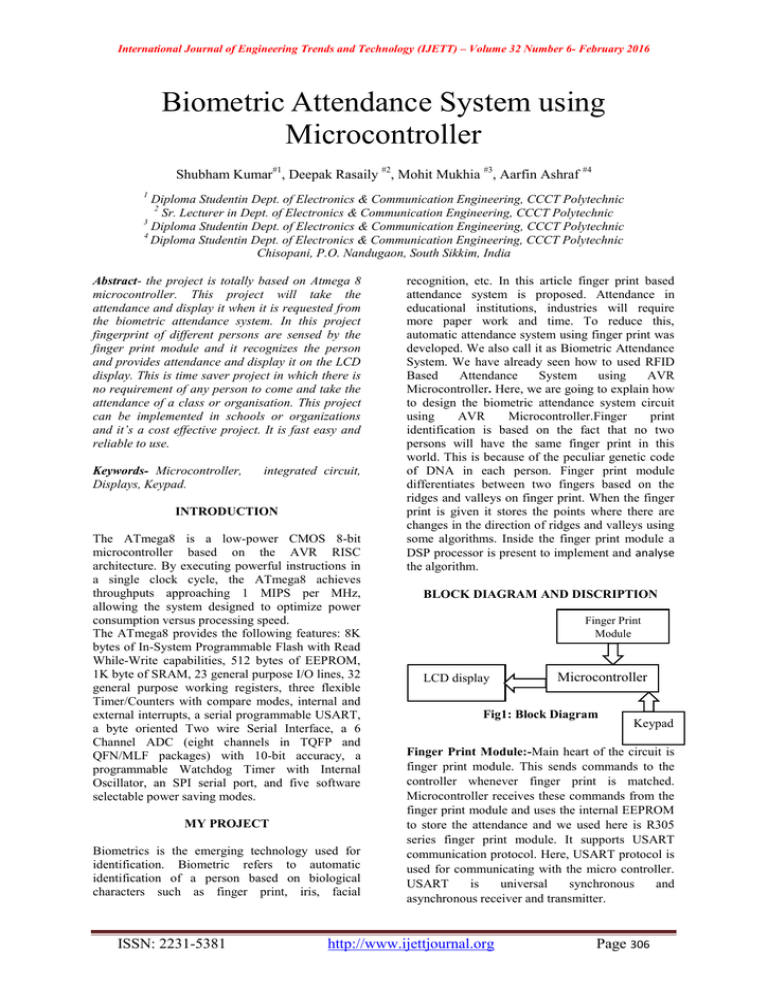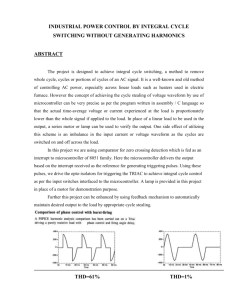Document 12917274
advertisement

International Journal of Engineering Trends and Technology (IJETT) – Volume 32 Number 6- February 2016 Biometric Attendance System using Microcontroller Shubham Kumar#1, Deepak Rasaily #2, Mohit Mukhia #3, Aarfin Ashraf #4 1 Diploma Studentin Dept. of Electronics & Communication Engineering, CCCT Polytechnic 2 Sr. Lecturer in Dept. of Electronics & Communication Engineering, CCCT Polytechnic 3 Diploma Studentin Dept. of Electronics & Communication Engineering, CCCT Polytechnic 4 Diploma Studentin Dept. of Electronics & Communication Engineering, CCCT Polytechnic Chisopani, P.O. Nandugaon, South Sikkim, India Abstract- the project is totally based on Atmega 8 microcontroller. This project will take the attendance and display it when it is requested from the biometric attendance system. In this project fingerprint of different persons are sensed by the finger print module and it recognizes the person and provides attendance and display it on the LCD display. This is time saver project in which there is no requirement of any person to come and take the attendance of a class or organisation. This project can be implemented in schools or organizations and it’s a cost effective project. It is fast easy and reliable to use. Keywords- Microcontroller, Displays, Keypad. integrated circuit, INTRODUCTION The ATmega8 is a low-power CMOS 8-bit microcontroller based on the AVR RISC architecture. By executing powerful instructions in a single clock cycle, the ATmega8 achieves throughputs approaching 1 MIPS per MHz, allowing the system designed to optimize power consumption versus processing speed. The ATmega8 provides the following features: 8K bytes of In-System Programmable Flash with Read While-Write capabilities, 512 bytes of EEPROM, 1K byte of SRAM, 23 general purpose I/O lines, 32 general purpose working registers, three flexible Timer/Counters with compare modes, internal and external interrupts, a serial programmable USART, a byte oriented Two wire Serial Interface, a 6 Channel ADC (eight channels in TQFP and QFN/MLF packages) with 10-bit accuracy, a programmable Watchdog Timer with Internal Oscillator, an SPI serial port, and five software selectable power saving modes. MY PROJECT Biometrics is the emerging technology used for identification. Biometric refers to automatic identification of a person based on biological characters such as finger print, iris, facial ISSN: 2231-5381 recognition, etc. In this article finger print based attendance system is proposed. Attendance in educational institutions, industries will require more paper work and time. To reduce this, automatic attendance system using finger print was developed. We also call it as Biometric Attendance System. We have already seen how to used RFID Based Attendance System using AVR Microcontroller. Here, we are going to explain how to design the biometric attendance system circuit using AVR Microcontroller.Finger print identification is based on the fact that no two persons will have the same finger print in this world. This is because of the peculiar genetic code of DNA in each person. Finger print module differentiates between two fingers based on the ridges and valleys on finger print. When the finger print is given it stores the points where there are changes in the direction of ridges and valleys using some algorithms. Inside the finger print module a DSP processor is present to implement and analyse the algorithm. BLOCK DIAGRAM AND DISCRIPTION Finger Print Module LCD display Microcontroller Fig1: Block Diagram Keypad Finger Print Module:-Main heart of the circuit is finger print module. This sends commands to the controller whenever finger print is matched. Microcontroller receives these commands from the finger print module and uses the internal EEPROM to store the attendance and we used here is R305 series finger print module. It supports USART communication protocol. Here, USART protocol is used for communicating with the micro controller. USART is universal synchronous and asynchronous receiver and transmitter. http://www.ijettjournal.org Page 306 International Journal of Engineering Trends and Technology (IJETT) – Volume 32 Number 6- February 2016 Microcontroller:-An ATmega8 microcontroller which is an AVR family microcontroller. It is 8 bit microcontroller and has 23 programmable input and output pins. It has 8 KB of flash memory, 512 bytes of EEPROM, 1KB of SRAM. Keypad:-A keypad is a set of buttons or keys bearing digits, symbols and/or alphabetical letters placed in order on a pad, which can be used as an efficient input device and we used 4*3 keypad in this project i.e. it has four rows and three columns. LCD Display:-Liquid crystal display is used for displaying the messages. Liquid crystal display is the technology used for displays in notebook and other smaller computers. Like light-emitting diode (LED) and gas-plasma technologies, LCDs allow displays to be much thinner than cathode ray tube (CRT) technology and we use CIRCUIT DIAGRAM to ground. Data can be transmitted or received using serial communication. Finger print processing involves two steps.1) finger enrolment and 2) finger matching. Initially, to enroll the finger user must give his finger print twice to the module. Module checks these two images and generates a template image and stores it. In the second step of finger matching, for 1:1 matching input finger print is matched with the template image generated and it generates an acknowledgement. For 1: N matching input is matched with the images in the library. It gives the matched image, a page id of the matched image is generated. Keypad used in this project is 4*3 keypad i.e. it has four rows and three columns. Columns of the keypad are connected to the PORT D pins of the microcontroller. PD5 to PD7 pins are connected to the three columns of the keypad. Rows are connected to the PORT C of the microcontroller. PC0 to PC3 pins are connected to the rows of the keypad. To give attendance, press 1 from the keypad and to enroll press 2 from the keypad, to clear all the data press 3 from the keypad. Liquid crystal display is used for displaying the messages. This is interfaced to PORTB of the micro controller. LCD in 4bit mode is connected to the micro controller. D4-D7 pins are connected to the PB0-PB3 pins of the microcontroller. RS pin is connected to the PB4, RW pin is connected to the PB5 and Enable pin is connected to the PB6 pin. RESULT AND SIMULATION The project has been tested in proteus and in breadboard and it is properly working. This circuit will sense the fingerprint of the employees or student and mark the person present for the particular day. CONCLUSION CIRCUIT DESCRIPTION In this circuit we used an ATmega8 microcontroller which is an AVR family microcontroller. It is 8 bit microcontroller and has 23 programmable input and output pins. It has 8 KB of flash memory, 512 bytes of EEPROM, 1KB of SRAM. Biometric module used here is R305 series finger print module. It supports USART communication protocol. Here, USART protocol is used for communicating with the micro controller. USART is universal synchronous and asynchronous receiver and transmitter. This module has four pins out 1) Transmit, 2) Receive, 3) Vin, 4) GND. Transmit pin is connected to the receive pin of the microcontroller. Receive pin should be connected to the transmit pin of the microcontroller. VIN is applied with a voltage of 5V and GND is connected ISSN: 2231-5381 Biometric attendance system can be used in industries for punching. Andin ATM authentication for financial purpose and in educational institutions for attendance of teachers and students daily. This is a time saver project. In this project there is no person required to take the attendance it is sensed by thefingerprint module itself and the attendance is provided to the respected person. REFERENCE [1] [2] [3] K A. Nagaty,“An Energy-Based Fingerprint Matching System”,Consumer Communications and Networking Conference, 2004. CCNC 2004. G. S. Ng1*, X. Tang, D. Shi11“Adjacent Orientation Vector Based Fingerprint Minutiae Matching System”, Proceedings of the 17th Wang Yuan1 Yao Lixiu1 Zhou Fuqiang2,“A Real Time Fingerprint Recognition System Based OnNovel http://www.ijettjournal.org Page 307 International Journal of Engineering Trends and Technology (IJETT) – Volume 32 Number 6- February 2016 [4] [5] Fingerprint Matching Strategy”,1-4244-1135-1/07/$25.00 ©2007 IEEE. Marcos Faundez-Zanuy& Joan Fabregas“Testing Report of a Fingerprint-Based Door-Opening System”,IEEE A&E SYSTEMS MAGAZINE.JUNE 2005. Wencheng Yang, Jiankun Hu, and Song Wang“A Delaunay Quadrangle-Based Fingerprint Authentication System with Template ProtectionUsing Topology Code for Local Registration and Security Enhancement” IEEE TRANSACTIONS ON INFORMATION FORENSICS ANDSECURITY, VOL. 9, NO. 7, JULY 2014. JianjiangFeng, “Combining minutiae descriptors forfingerprint matching”, Pattern Recognition, pp. 342 – 352,April 2007. [7] JianjiangFeng, and Anil K.Jain, “FingerprintReconstruction: From Minutiae to Phase”, IEEE Transactions, Vol. 33, No. 2, pp, 209-223, Feb.2011. [8] Anil K.Jain, and jianjiangfeng, “Latent Fingerprint Matching”, IEEE Transactions, Vol.33, pp.88 100, Jan.2011. [9] Yi (Alice) Wang, and Jiankun Hu, “Global RidgeOrientation modelling for Partial Fingerprint Identification,”IEEE Transactions, Vol.33, Pg.72-87, Jan.2011. [10] R.Cappelli, A.Lumini, D.Maio, and D.Maltoni,“Fingerprint Image Reconstruction from Standard Templates”,IEEE Transactions, Vol.29, pp.1489-1503, Sept.2007. and Research, Chandigarh, India. He worked as project Scientist in the Department of Science and Technology, Govt. of Sikkim prior to lecturer in CCCT. His area of interest is PLC and robotics, Microprocessor and Microcontroller and Digital Signal Processing. [3] [6] MohitMukhiais presently associated with the Department of Electronics and Communication Engineering at Centre for Computer and Communication Technology (CCCT- Govt. Polytechnic) Chisopani, South Sikkim, India as a student since 2013 to till date. [4] Authors: [1] Aarfin Ashraf is a final year Diploma student, Dept. Of Electronics and Communication Engineering from Centre for Computer and Communication Technology, Chisopani, South Sikkim. His main areas of interest are Antenna Design, PLC, Radar Signal Processing and Microwave Theory and Techniques. Shubham Kumaris presently associated with the Department of Electronics and Communication Engineering at Centre for Computer and Communication Technology (CCCT- Govt. Polytechnic) Chisopani, South Sikkim, India as a student since 2013 to till date. [2] Deepak Rasaily is presently associated with the Department of Electronics and Communication Engineering at Centre for Computer and Communication Technology (CCCT- Govt. Polytechnic) Chisopani, South Sikkim, India as a Senior Lecturer since 2003 to till date. He is MEScholar at National Institute of Technical Training ISSN: 2231-5381 http://www.ijettjournal.org Page 308








